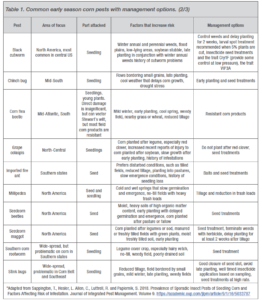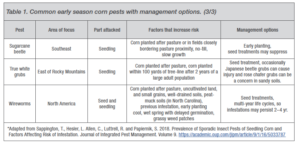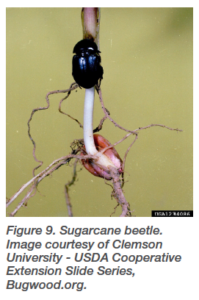- Early season corn pests destroy the seed or injury the seedling, that may result in reduced stands, uneven emergence, or plant stunting.
- Scout for injury symptoms when evaluating emergence progress.
- In some cases, intervention may not be possible with some seed pests, other above ground pests may be controlled with applications of an appropriate control tactic. In severe situations, replanting a portion of the field may be required.
Seed Pests
Pests that can feed on the seed are the seedcorn maggot, seedcorn beetle and slender seedcorn beetle, ants, and millipeds.
Seedcorn maggot
Seedcorn maggot larvae are yellowish white, about ¼-inch long and lack defined heads and legs. Larvae causes injury to the seed by burrowing into the kernel, thus resulting in reduced vigor and in some cases plant death (Figure 1). Fields with high organic matter, that have had animal manure applied or green manure from a cover crop that has been freshly incorporated are at higher risk, particularly in a wet, cool spring. A degree-day (DD) development models has been used to predict the timing of fly activity. Fifty percent of the overwintering generation emerges as adults after 371 DD (at 39 °F base) have accumulated based on the soil temperature in the top 2-inches of soil.
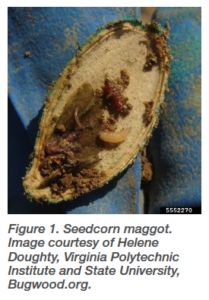
Seedcorn beetles
Seedcorn beetles (seedcorn beetle and slender seedcorn beetle) occasionally attack corn seeds. The seedcorn beetle is a yellowish-brown beetle about 5/16 inch long with a patch of black in the middle of each wing cover. The slender seedcorn beetle is a shiny reddish-brown beetle about ¼-inch long, with a noticeable restriction between the thorax and the abdomen. The plant injury is more common when cold, wet weather delays the corn emergence. These beetles will feed on and consume the seed’s germ, resulting in “hollowed-out” seed. Injury will usually result in reduced plant stands. If the adult feeds on the mesocotyl it may result in plant stunting and eventually reduction in crop yield.
Millipedes
Millipedes range in body size from 1/4 to 1 1/4 inches and are dark brown to black, the body is rounded and have antenna and each body segment has two pairs of legs (Figure 2). This distinguishes them from wireworm larvae that they are sometimes confused with in the field.
Millipedes are not insects but belong to a different class (arthropods) and usually not considered a significant pest of corn seeds. However, during cold wet springs, when seed germination is slowed and in fields with high plant residue or organic matter, injury can occur. This is particularly true when they can access the seed because the seed furrow did not completely close during planting. Seed treatments are not effective against millipedes.

Red Imported fire ant
The red imported fire ant can attack the seed and injury can be extensive when populations are high within the field. In some areas of Texas, the injury can be extensive and most likely related to moisture and temperature. Injury is more common in fields that have been undisturbed or in no-till production systems. If the seed is germinating it is more at risk and when planting conditions are not ideal, and the seed furrow does not collapse during planting allowing access to the seed, injury can be extensive. Particularly, under conditions that cause slow emergence.
Seed and Seedling Pests
Pests that can feed on the seed and seedling include, wireworm and southern corn rootworm.
Wireworm
Wireworm (there are many species) larvae are slender with only 6 legs and on the last abdominal segment an appendage that forms a “keyhole” type opening. Larva can range from ½ to 1-1/2 inches in length (Figure 3). There is soft- and hard-bodied wireworm species that range from pale white or shiny yellow to shiny brown in color. Wireworms are the larvae of click beetles. Click beetle females deposit eggs around the roots of grasses, which is why wireworms can be problematic in fields with a history of sod such as pasture or Conservation Reserve Program (CRP) fields. Wireworms may live in the soil for up to 6 or 7 years before pupating and emerging as adults. Injury tends to occur with early planted corn in conjunction with cold and wet conditions. Fields that are well drained are more likely to have infestations as compared to poorly drained fields. Larvae feed on the germ, resulting in similar “hollowed-out” seed injury of the seedcorn beetle complex. Wireworms will also feed on the underground portion of the root or stem of young corn plants by tunneling into them. Plants that survive will be stunted or wilted compared to surrounding plants. Once soils warm, wireworms will move deeper in the soil profile, reducing the injury potential.

Southern corn rootworm
The southern corn rootworm is widely distributed and unlike the western and northern corn rootworm it feeds on a wide variety of crops as both an adult and larvae and can have several generations per year. The adults survive the winter in only the southern states and move northward during the growing season. The adult deposits eggs in the soil at the base of host plants, in corn it is only the first generation that is economically damaging. The larvae may attack the seed, in which injury can be confused with wireworm injury or tunnel into the mesocotyl killing the plant or severely stunting it. Interestingly, the Bt trait that controls the western and northern corn rootworm does not provide control for this species. Injury can be more severe when a legume cover crop is used. Termination of the cover crop less than 4 weeks prior to planting increases the risk. No-till cropping systems that utilize a cover crop are more at risk.
Seedling Pests
Those that are almost exclusive pests of the seedling include billbugs (many species but primarily maize billbug), chinch bugs, corn flea beetle, cutworms (many species), grape colaspis, slugs, southern corn leaf beetle, webworms (several species), and white grub (both true and annual species).
Billbug
There are several species of billbugs that can injure corn. The two major species are the southern corn billbug in the South and the maize billbug (Figure 4) in the Corn Belt. Adults usually only walk from overwintering sites to host plants, therefore, the injury that is done is usually localized to field borders. Nutsedge and corn are the predominant hosts for both species. Adults feed on the above portion of the plant and females oviposit in their feeding punctures and the developing larvae migrate down the stem. Occasionally, the female will deposit eggs in the soil and larvae will feed on the roots. When the growing point is injured, excessive tillering and plant stunting can occur and, in some cases, plant death.
In the Atlantic Coastal Plain billbugs are a serious annual pest. Outside of this region the injury is more sporadic and often minor. Crop rotation and control of yellow nutsedge can help limit the potential for injury. Fields in continuous corn production in no-till systems are at higher risk of injury by billbugs.

Chinch bugs
Chinch bugs are small, roughly 1/6 inch, with a black body and white forewings that create a white ‘X’ on the abdomen (Figure 5). Newly hatched nymphs are bright red. Chinch bugs feed on the crowns and stems of corn plants and below ground on roots. Feeding damage from adults and nymphs causes reddish discoloration of leaves and stems.
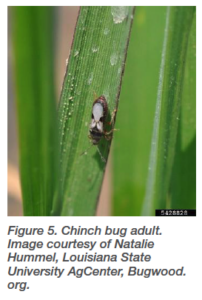
Corn flea beetle
The corn flea beetle is mostly a concern in the central and eastern US and causes little economic injury in the southern states. The adult overwinters in grassy areas and migrates to corn as it emerges, and temperatures allow insect activity (Figure 6). Large number of beetles can result in economic injury when the seedling stage is attacked. Harsh winter conditions can eliminate corn flea beetle adults and lower the risk of economic injury. This insect is a vector for Stewart’s wilt, a bacterial pathogen, that can infect susceptible corn products resulting in economic loss. Early planting timed to emergence of the adults can increase the risk of infestation, particularly when plant growth is slowed. Weedy fields may be at more of a risk.

Cutworms
Cutworms are the larval stage of moths and there are several species that can attack corn Cutworms can vary in their feeding habit. The most economically important is the black cutworm. Black cutworm larvae feed below ground and sever corn plants from their roots near the soil line (Figure 7). Dingy cutworms climb the plant and consume leaf and stem tissue, while sandhill cutworms feed on the plant under-ground. Larval feeding can occur at the base of corn plants or underground, which results in wilted or completely clipped seedlings. The recommended injury threshold is when 5% of the plants are cut for those species which feed above ground.

Grape colapsis
The grape colapsis is a sporadic pest mainly in the Central Corn Belt. Larvae resemble a very small white grub with a lightly curved, small white body with a tan head that are approximately 1/8-1/6 inch in length. Larvae overwinter in the soil and feed on the roots of the small seedlings, and several are usually found feeding on single plant. Feeding can limit water and nutrient uptake so damaged plants may appear wilted, stunted, or as if they have a nutrient deficiency from above the soil surface. Uprooting damaged plants will reveal the larvae
Because egg laying occurs in soybean, alfalfa, and other legumes, corn following a legume can be at higher risk. Injury can be more pronounced when seedling growth is slowed. There is not a recommend sampling program or economic threshold established for this pest, as well no rescue treatments in response to injury.
Slugs
Slugs can cause injury to corn seedlings by rasping the leaf tissue resulting in long vertical lines of dead tissue. In most cases, corn can out-grow the injury. Seed treatments are not effective for control of slugs. Injury is more common in no-till or reduced tillage fields and in springs followed by a mild winter.
Southern corn leaf beetle
The southern corn leaf beetle injury has become more common in the Corn Belt. The beetle is a small, <1/4 inch, dark beetle that is difficult to see as it blends in with the soil and readily drops to the ground when approached (Figure 8). The beetle feeds on the leaf margins and the stem. The damage can easily be mistaken as young cutworm or armyworm feeding. Stand reduction can occur, particularly while conditions are poor for rapid seedling growth.
The female deposits eggs at the base of the plants and larvae feed on the roots of corn during the early summer. Scouting for this pest can occur when scouting for cutworm injury, treatment is recommended when 25% infested/damage plants are found.
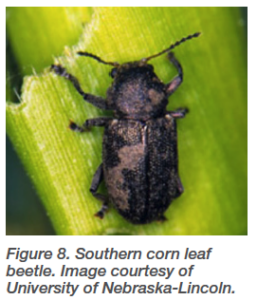
Sugarcane beetle
Sugarcane beetle is economically important in the Southeastern US and causes injury in the adult stage (Figure 9). The adults emerge from grassy field margins or pasture and migrate to corn fields to feed on newly emerged plants. The feed below the soil line and chew through the mesocotyl. The injury results in killed seedlings or stunted if feeding occurs on larger plants. A single adult can injure several plants and the resulting stand loss can result in yield losses. However, the injury is often sporadic, isolated, and unpredictable. Fields at the highest risk border grassy areas.
Sod webworms
There are several species of sod webworms, but the two most common that may attack corn are the corn root webworm and the bluegrass webworm. The larvae are off-white with numerous small black spots with numerous pale hairs. Webworms are very active and will move vigorously when handled. These are occasional pests in early corn. Plants in relatively small areas can be killed by sod webworm caterpillars during late May and early June. Damage usually occurs more severe when corn follows sod, and injury is scattered throughout the field. Under severe infestations, up to 75% of the plants from an infested areas may be injured. Injury occurs near ground level that can result in plants that are cut off and partially dragged tunnels made by larvae. This type of injury is very similar to that caused by cutworms, especially the black cutworm; however, webworms usually consume more of the plant.
White grubs
White grubs are occasional pests of corn seedlings. Annual white grubs (ex: Japanese beetle) have a one-year life cycle with the grub stage from late July through mid-June the following year. True white grubs (ex: May and June beetles) have a two to three-year life cycle with the grub stage from August through the next year and sometimes during portions of the third year (Figure 10). Annual grubs tend to be more sporadic and rarely result in economic injury to corn. The true white grub is more wide-spread and usually a more common pest of corn. White grub damage typically appears as stunted, wilted, discolored, or dead seedlings and/or as gaps in rows where plants fail to emerge. White grubs prune roots and can feed on the mesocotyl causing plant death. Injury is usually more severe when corn follows sod or pasture. Additionally, field surrounded by trees, (popular, cottonwood, willow and ash) are attractive to the adults that feed on the leaves, with females then laying eggs in the soil near the trees. Therefore, 2 years after high numbers of adults are noticed feeding on leaves, the risk of injury by 2nd instar larvae is the highest. There are no rescue treatments labeled for white grub infestations. Preventative measures should be taken before planting if scouting reveals a presence of true white grubs in a field.

Management Tactics
There are several management practices that can help reduce early season corn insect damage (Table 1). Crop rotation with a non-grass crop, conventional tillage, and timely planting in good soil conditions can help reduce corn seedling stress and align timing of corn insect susceptibility with lower insect pressure. With the subterranean pests, there are no responsive management tactics available so the reliance on preventative tactics is the only management strategy. Insecticide rescue treatments are available for some insects; however, timing is critical, which makes preventative treatments beneficial and necessary for some insect species. Insecticidal seed treatments can help to control several early season insects for up to 30 days after planting. Insecticide seed treatment products, such as clothianidin, can help reduce damage caused by secondary pests including: seedcorn maggot, white grub, wireworm, black cutworm, Japanese beetle larva, and chinch bug.

